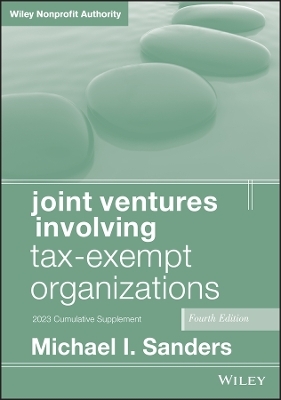
Joint Ventures Involving Tax-Exempt Organizations, 2023 Supplement
John Wiley & Sons Inc (Verlag)
978-1-394-21387-0 (ISBN)
In the 2023 Cumulative Supplement to the fourth edition of Joint Ventures Involving Tax-Exempt Organizations, veteran tax attorney Michael I. Sanders delivers an essential update to the premier text on the subject of joint ventures with tax-exempt organizations. You’ll discover every relevant and recent development in the liability of, and consequences to, exempt organizations participating in joint ventures with for-profit and other tax-exempt entities.
This authoritative guide offers unmatched access to relevant IRC provisions, Treasury regulations, IRS rulings, relevant judicial rulings, and legislative developments that impact exempt organizations considering or involved in joint ventures. You’ll also find:
Sample models, checklists, and numerous citations to Internal Revenue Code sections, Treasury Regulations, case law, and IRS rulings
Suggestions for structuring joint ventures and minimizing the risk of audit or penalties
Written by a recognized expert in this complex and rapidly evolving field, the 2023 Cumulative Supplement is a must-read resource for tax attorneys, accountants, and professionals working with tax-exempt organizations.
Preface xi
Acknowledgments xv
Chapter 1: Introduction: Joint Ventures Involving Exempt Organizations 1
§ 1.4 University Joint Ventures 1
§ 1.5 Low-Income Housing and New Markets Tax Credit Joint Ventures 1
§ 1.6 Conservation Joint Ventures 2
§ 1.8 Rev. Rul. 98-15 and Joint Venture Structure 2
§ 1.10 Ancillary Joint Ventures: Rev. Rul. 2004-51 2
§ 1.14 The Exempt Organization as a Lender or Ground Lessor 2
§ 1.15 Partnership Taxation 3
§ 1.17 Use of a Subsidiary as a Participant in a Joint Venture 3
§ 1.22 Limitation on Private Foundations’ Activities That Limit Excess Business Holdings 4
§ 1.24 Other Developments 4
Chapter 2: Taxation of Charitable Organizations 9
§ 2.1 Introduction 9
§ 2.2 Categories of Exempt Organizations 15
§ 2.3 § 501(c)(3) Organizations: Statutory Requirements (Revised) 19
§ 2.4 Charitable Organizations: General Requirements 25
§ 2.5 Categories of Charitable Organizations (Revised) 26
§ 2.6 Application for Exemption 30
§ 2.7 Governance 40
§ 2.8 Form 990: Reporting and Disclosure Requirements 41
§ 2.9 Redesigned Form 990 44
§ 2.10 The IRS Audit 44
§ 2.11 Charitable Contributions 49
Chapter 3: Taxation of Partnerships and Joint Ventures 61
§ 3.1 Scope of Chapter 61
§ 3.3 Classification as a Partnership (Revised) 64
§ 3.4 Alternatives to Partnerships 77
§ 3.7 Formation of Partnership 77
§ 3.8 Tax Basis in Partnership Interest 78
§ 3.9 Partnership Operations 79
§ 3.10 Partnership Distributions to Partners 79
§ 3.11 Sale or Other Disposition of Assets or Interests 80
§ 3.12 Other Tax Issues 80
Chapter 4: Overview: Joint Ventures Involving Exempt Organizations 85
§ 4.1 Introduction 85
§ 4.2 Exempt Organization as General Partner: A Historical Perspective 86
§ 4.6 Revenue Ruling 2004-51 and Ancillary Joint Ventures 88
§ 4.9 Conversions from Exempt to For-Profit and from For-Profit to Exempt Entities 88
§ 4.10 Analysis of a Virtual Joint Venture 89
Chapter 5: Private Benefit, Private Inurement, and Excess Benefit Transactions 91
§ 5.1 What Are Private Inurement and Private Benefit? 91
§ 5.2 Transactions in Which Private Benefit or Inurement May Occur 93
§ 5.3 Profit-Making Activities as Indicia of Nonexempt Purpose 94
§ 5.4 Intermediate Sanctions 95
§ 5.7 State Activity with Respect to Insider Transactions 105
Chapter 6: Engaging in a Joint Venture: The Choices 107
§ 6.1 Introduction 107
§ 6.2 LLCs 108
§ 6.3 Use of a For-Profit Subsidiary as Participant in a Joint Venture (Revised) 109
§ 6.5 Private Foundations and Program-Related Investments (Revised) 121
§ 6.6 Nonprofits and Bonds 125
§ 6.7 Exploring Alternative Structures (Revised) 127
§ 6.8 Other Approaches (Revised) 131
Chapter 7: Exempt Organizations as Accommodating Parties in Tax Shelter Transactions 145
§ 7.2 Prevention of Abusive Tax Shelters (Revised) 145
§ 7.3 Excise Taxes and Penalties 146
Chapter 8: The Unrelated Business Income Tax 147
§ 8.1 Introduction 147
§ 8.3 General Rule 148
§ 8.4 Statutory Exceptions to UBIT 149
§ 8.5 Modifications to UBIT 150
§ 8.7 Calculation of UBIT 150
Chapter 9: Debt-Financed Income 167
§ 9.1 Introduction 167
§ 9.2 Debt-Financed Property 167
§ 9.3 The §514(c)(9) Exception (Revised) 168
§ 9.6 The Final Regulations 169
Chapter 10: Limitation on Excess Business Holdings 171
§ 10.1 Introduction (Revised) 171
§ 10.2 Excess Business Holdings: General Rules (Revised) 171
§ 10.3 Tax Imposed 175
§ 10.4 Exclusions 176
Chapter 11: Impact on Taxable Joint Ventures: Tax-Exempt Entity Leasing Rules (Revised) 181
§ 11.3 Internal Revenue Code § 168(h) 181
§ 11.5 Restrictions on Tax-Exempt Use Property (New) 181
Chapter 12: Health Care Entities in Joint Ventures 187
§ 12.1 Overview 187
§ 12.2 Classifications of Joint Ventures 188
§ 12.3 Tax Analysis 189
§ 12.4 Other Health Care Industry Issues 191
§ 12.5 Preserving the 50/50 Joint Venture 192
§ 12.9 Government Scrutiny 192
§ 12.11 The Patient Protection and Affordable Care Act of 2010: § 501(r) and Other Statutory Changes Impacting Nonprofit Hospitals 193
§ 12.12 The Patient Protection and Affordable Care Act of 2010: ACOs and Co-Ops: New Joint Venture Health Care Entities 196
Chapter 13: Low-Income Housing, New Markets, Rehabilitation, and Other Tax Credit Programs 197
§ 13.2 Nonprofit-Sponsored LIHTC Project 197
§ 13.3 Low-Income Housing Tax Credit 198
§ 13.4 Historic Investment Tax Credit 202
§ 13.6 New Markets Tax Credits (Revised) 212
§ 13.10 The Energy Tax Credits 227
§ 13.11 The Opportunity Zone Funds: New Section 1400Z-1 and Section 1400Z-2 (Revised) 229
§13.12 The Inflation Reduction Act (New) 295
Appendix 13B 303
Chapter 14: Joint Ventures with Universities 319
§ 14.1 Introduction 319
§ 14.3 Colleges and Universities IRS Compliance Initiative 325
§ 14.5 Faculty Participation in Research Joint Ventures 326
§ 14.6 Nonresearch Joint Venture Arrangements 328
§ 14.7 Modes of Participation by Universities in Joint Ventures (Revised) 329
Chapter 15: Business Leagues Engaged in Joint Ventures 343
§ 15.1 Overview 343
§ 15.2 The Five-Prong Test 344
§ 15.3 Unrelated Business Income Tax 345
Chapter 16: Conservation Organizations in Joint Ventures 347
§ 16.1 Overview 347
§ 16.2 Conservation and Environmental Protection as a Charitable or Educational Purpose: Public and Private Benefit 347
§ 16.3 Conservation Gifts and § 170(h) Contributions (Revised) 348
§ 16.7 Emerging Issues 376
Chapter 17: International Joint Ventures 377
§ 17.5 General Grantmaking Rules 377
§ 17.11 Application of Foreign Tax Treaties 379
Chapter 19: Debt Restructuring and Asset Protection Issues 381
§ 19.1 Introduction 381
§ 19.2 Overview of Bankruptcy 381
§ 19.3 The Estate and the Automatic Stay 382
§ 19.4 Case Administration 383
§ 19.5 Chapter Plan 384
§ 19.6 Discharge 385
§ 19.7 Special Issues: Consequences of Debt Reduction 385
Index 387
| Erscheinungsdatum | 03.01.2024 |
|---|---|
| Verlagsort | New York |
| Sprache | englisch |
| Maße | 175 x 246 mm |
| Gewicht | 658 g |
| Themenwelt | Wirtschaft ► Betriebswirtschaft / Management ► Planung / Organisation |
| ISBN-10 | 1-394-21387-5 / 1394213875 |
| ISBN-13 | 978-1-394-21387-0 / 9781394213870 |
| Zustand | Neuware |
| Haben Sie eine Frage zum Produkt? |
aus dem Bereich


